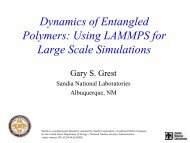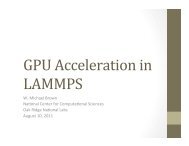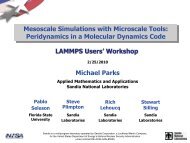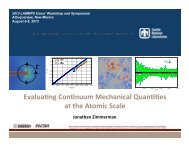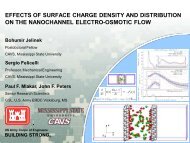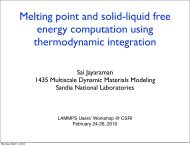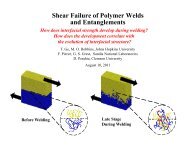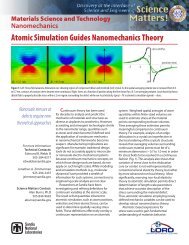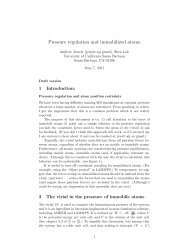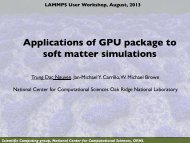NOVAK, MAGINN, AND MCCREADYPHYSICAL REVIEW B 75, 085413 2007FIG. 5. Volume as a function <strong>of</strong> time for the weak <strong>and</strong> <strong>homogeneous</strong>cases. Open symbols are the points at the <strong>nucleation</strong> time.Filled symbols are the volumes used to calculate the averagevolume.The differences in <strong>nucleation</strong> rates between the <strong>heterogeneous</strong>systems were correlated with the strength <strong>of</strong> interactionbetween the fluid <strong>and</strong> the solid, <strong>and</strong> consequently withthe ordering near the <strong>nucleation</strong> site. Making the surfacemore attractive decreased the <strong>nucleation</strong> rates, but there wasa limit to this. Once the interactions were strong enough toinduce solidlike order <strong>of</strong> the fluid near the surface, furtherincreasing the interaction energy had little effect on <strong>nucleation</strong>rates. Thus the strong <strong>and</strong> neutral surfaces had similar<strong>nucleation</strong> rates, while the weak case had much higher ratesat the same temperature.Changing the threshold volume used to determine the<strong>nucleation</strong> times in the <strong>heterogeneous</strong> cases from 15 to 30%above the average volume usually increased the <strong>nucleation</strong>rate. As shown in Table III, the average increase was 37.5%in the weak case. In the neutral case, the average increasewas 26.1%, while in the strong case the average change was9.3%. In the neutral <strong>and</strong> strong case the <strong>nucleation</strong> rate decreasedfor the lowest <strong>and</strong> two lowest temperatures, respectively.In these cases the increase in <strong>nucleation</strong> rate also becamelarger with increasing temperature.FIG. 6. Number density pr<strong>of</strong>iles for the three <strong>heterogeneous</strong>cases at the initial state point 96.0 K. The first four peaks are thesolid layers <strong>and</strong> the other peaks are fluid. All three cases show someordering near the solid surface. There is also some ordering at largez due to the top wall potential. The more attractive surfaces showmore ordering <strong>and</strong> this ordering extends further into the liquid.FIG. 7. Nucleation times vs the negative logarithm <strong>of</strong> the ratio<strong>of</strong> the number <strong>of</strong> nonnucleated simulations to the total number <strong>of</strong>simulations. The symbols are simulation results for the neutral case<strong>and</strong> lines are the fit to Eq. 7. The temperatures in the legend arethe set point temperatures.When controlling the temperature <strong>of</strong> the solid <strong>and</strong> fluidseparately, <strong>nucleation</strong> rates increased by up to a factor <strong>of</strong>four with the largest difference at the highest temperature.This was probably due to the increasing difference in fluidtemperature compared to set point temperature as seen inFig. 2. Time lags t 0 were essentially unchanged. The netresult was that, while differences in thermostatting methoddid affect the actual values obtained for the <strong>nucleation</strong> rate, itdid not appear to qualitatively change the basic finding thatthe presence <strong>of</strong> even a smooth surface with no solid or fluidimpurities greatly enhances <strong>nucleation</strong> rates when comparedTABLE III. <strong>Comparison</strong> <strong>of</strong> steady state <strong>nucleation</strong> ratesm −3 s −1 10 −35 for the one thermostat <strong>heterogeneous</strong> cases whenthe <strong>nucleation</strong> times were at 1.15 times the average volume or 1.3times the average volume. Estimated fluid temperatures T fl as wellas set point temperatures T set are shown. Numbers in parenthesesare the 68.3% confidence intervals.T set K T fl K J s 1.15 J s 1.3Weak132.0 130.30 0.250.182, 0.360 0.290.218,0.431133.0 130.41 0.60.44, 0.88 0.90.67,1.3134.0 130.25 42.7, 5.4 53.7,7.0135.0 130.82 75.0, 9.9 96.4,12135.5 131.00 85.9, 12.3 107.38,15.1136.0 131.21 53.5, 7.1 75.6,11Neutral134.0 133.57 0.0120.0081, 0.0192 0.0120.0082,0.0180135.0 134.17 0.100.072, 0.149 0.100.0726,0.149135.5 134.46 0.40.25, 0.54 0.60.40,0.88136.0 134.81 1.81.29, 2.70 2.51.79,3.90Strong134.5 134.05 0.0170.0116, 0.0276 0.0160.0116,0.0255135.0 134.41 0.050.035, 0.076 0.050.035,0.073135.5 134.67 0.180.122, 0.291 0.190.135,0.295136.0 134.95 0.50.39, 0.83 0.70.49,1.1085413-6
COMPARISON OF HETEROGENEOUS AND HOMOGENEOUS…PHYSICAL REVIEW B 75, 085413 2007TABLE IV. Free energies kJ/mol nuclei, pre-exponential factorsm −3 s −1 <strong>and</strong> steady state <strong>nucleation</strong> rates m −3 s −1 10 −35 from the classical theory at the temperatures used in the <strong>homogeneous</strong>case.Temperature K143.5 143.7 144.0 144.5G 12.11 11.35 10.25 8.6535ln A 90.59 90.56 90.55 90.50J s 0.8584 1.605 4.036 15.00FIG. 8. Steady state <strong>nucleation</strong> rate J s vs 1/T for all cases. Errorbars are the 68.3% confidence intervals. The weak case data shownare for two thermostats. For the neutral <strong>and</strong> strong cases, the solidsymbols are using the fluid temperature instead <strong>of</strong> set point temperatureopen symbols. The line is the classical <strong>nucleation</strong> theoryresult for the same temperatures as the <strong>homogeneous</strong> case.to <strong>homogeneous</strong> <strong>nucleation</strong>. Furthermore, the weakly attractivesurface induces <strong>nucleation</strong> much more readily than aneutral or strongly attractive surface.C. Temperature dependence <strong>of</strong> <strong>nucleation</strong> rate <strong>and</strong>comparison to classical <strong>nucleation</strong> theoryThe <strong>nucleation</strong> rate as a function <strong>of</strong> inverse temperature isplotted in Fig. 8 for all cases. The solid <strong>and</strong> fluid were independentlythermostatted for the weak case. For the strong<strong>and</strong> neutral cases, <strong>nucleation</strong> rates are shown using both theset point <strong>and</strong> fluid temparatures.Nucleation is an activated process, so the steady state<strong>nucleation</strong> rate should be related to the free energy changefor <strong>nucleation</strong> via an Arrhenius-type expression,lnJ s =lnA − Gk B T .8Although the data in Fig. 8 appear to be reasonably linear,both the pre-exponential factor A <strong>and</strong> free energy changeG are functions <strong>of</strong> temperature. For this reason, it was notpossible to estimate reasonable free energy activation barriers.However, it is possible to compare the <strong>homogeneous</strong>simulation results with classical <strong>nucleation</strong> theory. The classicaltheory gives the <strong>nucleation</strong> rate for a superheated singlecomponent system as follows: 37J s = l 3 lv1/2mexp−16 lv33k B T l P sat − P l 2, = exp P l − P sat. 9 l k B T lThe <strong>nucleation</strong> rate depends on the number density <strong>of</strong> theliquid l , liquid-vapor surface tension lv , mass <strong>of</strong> a moleculem, temperature T l , saturation pressure P sat , <strong>and</strong>liquid pressure P l . The saturation pressure was calculatedusing the Lennard-Jones equation <strong>of</strong> state. 28 The followingexperimental correlation for the temperature dependence <strong>of</strong>the liquid-vapor surface tension for argon was used Ref.38, lv = 3.823 10 −21− T T c1.2927,T c = 158.9K,10where T c is the Lennard-Jones critical temperature used byJohnson et al. 28 The number density <strong>of</strong> the liquid was calculatedfrom the volumes obtained from the simulations. Thefree energy change is given byG =<strong>and</strong> the critical radius is316 lv3P sat − P l 2 ,112 lvr crit = .12P sat − P lUsing Eqs. 9 <strong>and</strong> 11, the <strong>nucleation</strong> rates <strong>and</strong> free energieswere calculated at the temperatures used in the simulations.The classical <strong>homogeneous</strong> <strong>nucleation</strong> rates, free energychanges, <strong>and</strong> pre-exponential factors obtained from Eq. 9are shown in Table IV <strong>and</strong> plotted in Fig. 8. The classical<strong>nucleation</strong> rates were an order <strong>of</strong> magnitude greater than thesimulated <strong>nucleation</strong> rates given in Table II. Previous simulationresults have been compared to the classical theory <strong>and</strong>predicted <strong>nucleation</strong> rates that were 17 orders <strong>of</strong> magnitudehigher, 6 three to four orders <strong>of</strong> magnitude higher, 7 <strong>and</strong> eightorders <strong>of</strong> magnitude lower 5 than the classical results. Zeng<strong>and</strong> Oxtoby 39 calculated <strong>nucleation</strong> rates using density functionaltheory <strong>and</strong> found they were at least ten orders <strong>of</strong> magnitudehigher than the classical theory. Shen <strong>and</strong>Debenedetti 16 calculated free energy changes <strong>and</strong> found thatthe classical free energy change was increasingly larger thanthe simulated one with increasing temperature, meaning thatthe classical <strong>nucleation</strong> rates decrease too rapidly with increasingtemperature. The size dependence <strong>of</strong> the surfacetension should lead to an underestimate <strong>of</strong> <strong>nucleation</strong> ratesby the classical theory. 40 The fact that our results matchedthe classical theory results better than those mentioned aboveis probably due to the surface tension <strong>and</strong> state point weused. Without data at other state points <strong>and</strong> a better estimation<strong>of</strong> surface tension, no general conclusion about the accuracy<strong>of</strong> the classical theory can be derived from this work.085413-7



